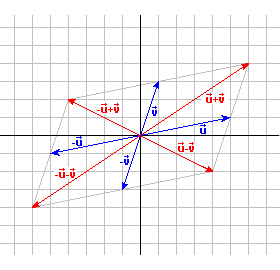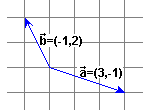|
ACTIVITY 2.6 |
|||
|
You remember that the subtraction It is easy to see that the components of -
Summarizing, the additions/subtractions of two vectors |
 |
|
INTERACTIVE ACTIVITY You have two vectors - - You can move the extremes of the vectors Each vector goes along with his components. You check how components obtains of SOLUTION (Animation) |
|
| HOMEWORK |
|
They give you the vectors |
 |
![]() =
=![]() +
+![]() ,
, ![]() = -
= -![]() +
+![]() ,
, ![]() = -
= -![]() -
-![]() and
and ![]() =
=![]() -
-![]()
You calculate also the components of vectors![]() ,
,![]() ,
,![]() and
and![]() .
.
|
END OF ACTIVITY 2.6 |
|||